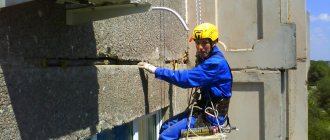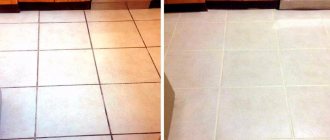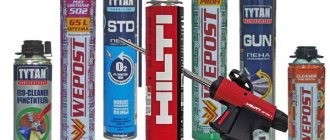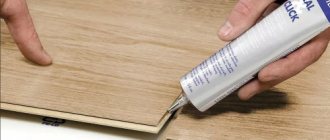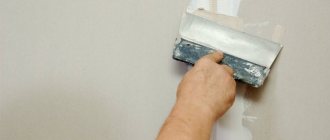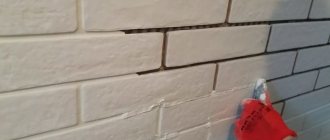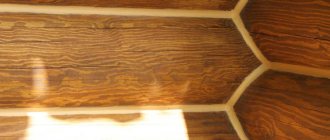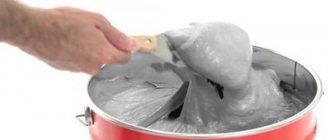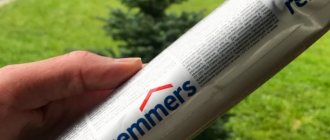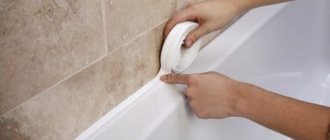To solve this problem, you need to insulate and repair seams in panel houses.
Such work requires large expenses and is carried out by contractor organizations during the next home renovation.
How to seal a shallow interpanel seam
Small interpanel seams can be repaired with simple cement mortar. If it's just aesthetic and doesn't blow anything out of the seam, then that's enough. If you missed a seam, then most likely you need to embroider it and first contact the management company so that they can see from the outside what is wrong.
If nothing is missed, for reliability and plasticity of the structure, you can pour polyurethane foam into the seam if the tip of the gun (or hose) enters the seam. The main thing is to leave room for plaster.
External repair of interpanel seams as the most reliable and effective way to seal them
In the vast majority of cases, the problem of depressurization of joints between panels can only be solved by repairing them outside the house, which for multi-storey buildings implies the need to involve industrial climbers in the work process.
When choosing this repair tactic, the seams are opened along their entire length, and the cleaned cavity is filled with polyurethane foam or a combination of this sealant and Vilaterm. After the sealants have cured, the joint is covered with a thin layer of putty to complete the sealing process.
Despite the high efficiency of external restoration, repairing joints between panels cannot always be carried out in this way and sealing joints from inside the apartment can be a temporary alternative.
Documents required for work
Sealing of apartments above the 2nd floor is carried out using the industrial mountaineering method. That is, specialists will need free access to the roof to deploy equipment.
To do this, you need to submit an application and a package of documents to the house management organization (Dez, Tsh, Zhsk, Zhilischnik). As a rule, we deliver all the documents ourselves; only a signature is required from the owner.
We recommend: Adhesive liquid nails: application features
Package of documents:
- Application for repair of interpanel seams;
- Sample letter of guarantee for access to the roof (guarantee on behalf of our company);
- Certificate of industrial climbers.
Why do seams break and what are the consequences?
The joint between panels is the weak point of any panel structure. It is these seams that mainly suffer from the influence of meteorological factors, such as sudden temperature changes (frequent transitions through zero), constant high humidity in winter (relevant for the entire Moscow region). In summer, the seams between the panels dry out due to exposure to ultraviolet rays (direct sunlight). Therefore, cracks and mold often appear at the joints of the slabs, leaks occur, and air and moisture pass through in winter. Due to such damage, condensation and excess moisture appear in the space between the panels, and drafts and fungi appear in the rooms, humidity increases and the temperature in the room decreases.
What do we use to seal and repair seams?
Our team of industrial climbers is ready to offer you high-quality and affordable services for sealing and repairing seams in stone, brick, panel, block and other houses of any series. All work is carried out using certified safe and modern materials. The materials we use are frost-resistant, durable and environmentally friendly. Collaborative work can be done at any time of the year.
We have the most favorable conditions
We can offer a flexible payment system, moreover, the cost of our work is no higher than that of our competitors, and for some services we can offer you even more favorable prices!
What materials to use
The gaps between the plates are filled using Polymerfex polyurethane foam. If the Vilaterm tubular type insulation material is selected, it must be laid in bitumen pastes or mastic.
You can moisture-proof the insulation with mastic. It is applied outside the joints. The mastic will protect the insulation material not only from moisture, but also from sunlight. On each side of the seam, the mastic should cover the panel by 3 cm.
Signs of leakage
The destruction of materials filling the internal space of the joint between panels rarely goes unnoticed, as it is accompanied by depressurization of the seam, which entails a huge number of problems that negatively affect the comfortable living conditions of all residents of a condominium residential building. Residents of these houses literally physically feel such problems, since they are in the air, are reflected on the walls of the apartments, and negatively affect the well-being and health of apartment residents, especially children and the elderly.
The main factors indicating a violation of the tightness of seams in a panel apartment building include the following:
- The occurrence of a leak or frostbite in the area of the joints, which indicates their significant deformation.
- There is high humidity in apartments.
- Peeling of wallpaper, the appearance of mold and mildew on the surface of the walls.
- Deterioration of the microclimate due to humidity, mold, dust and polluted air from the street.
- The appearance of drafts that can be felt even with closed windows and doors.
- Violation of the temperature regime, increased heating costs in winter and high air conditioning costs in hot weather.
What is primary lubrication?
When considering the topic of preventing disruption of the expansion of seam gaps between panels and timely repair of cracks on the wall, they always talk about sealing - a necessary stage of construction or restoration work.
can be primary or secondary
Secondary sealing refers to a type of repair work that is used during the operation of the building if, upon inspection of the wall surface, deficiencies are discovered that require urgent elimination (about the repair of external seams in a panel house - here).
Primary sealing helps to reliably fasten the panels together, protect the layers of the wall pie from external negative influences from the street, as well as the room.
Ice is especially dangerous because it expands the space between the tiles and deforms the material from which the tile structure is built - this disrupts the geometry, and when the ice melts, it forms areas of dampness. Therefore, any type of panel, even monolithic, necessarily needs sealing of the joint space, which protects the building from destruction.
Primary sealing for a new house can extend the life of the walls, prevent excessive moisture formation and mold, and protect against extraneous noise and sounds. Sealing is also needed to prevent damage, protect against insects, and strengthen the joint wall space.
Secondary sealing can be used after 5-7 years
Internal sealing prevents the formation of unpleasant odors and sharp sounds in the rooms and prevents the entry of rodents. Insulated joints not only prevent heat loss, but also provide the house with stability in the event of excessive seismic activity.
Seam insulation and anti-mold treatment
Insulation of seams is carried out using the “Warm seam” technology - this is when the space between the panels is insulated through holes drilled at a distance of 15-20 cm through Vilaterm or a thin layer of plaster (for some series P-44T, P3-M, KOPE, I-155 etc.) In the series (I-515/5 II-18/12 P II-68 1-515 / 9M, etc.) Insulation can be poured only with an open seam. This is called 100% seam opening. Macroflex insulation is poured into the seam, then the Vilaterm joint is laid and the seam is finally sealed with Oxyplast or Rustil mastic (sealant). Treatment with an anti-mold compound is carried out if there is mold in the seam.
Technology of sealing and insulation work in detail:
“Hot seam” is a modern, reliable and durable technology, therefore this method of repair (or primary sealing) of joints between slabs is one of the most relevant services of our company. The entire range of work is carried out primarily at heights and in any weather, and therefore requires not only special equipment and unprecedented safety measures, but also significant qualifications of the working personnel. Our company employs industrial climbers with extensive experience, and the main component of the selection criterion for our personnel is (among other things) a high level of personal responsibility.
Our company’s specialists guarantee the implementation of a full range of construction work to implement the “Warm Seam” technology. This set of works includes the following stages. 1. Pre-insulate the joints between the slabs to protect them from external precipitation. This stage applies to new buildings and houses that have just been put into operation. The gap between the panels is filled with foam under pressure and insulated with a special pipe, which is “embedded” in the foam. Then everything is leveled with a solution and additionally sealed with a special sealant. This sequence of actions guarantees maximum results in terms of waterproofing, thermal insulation and resistance to UV rays. 2. The second option concerns the reconstruction of joints in panel houses as part of a major renovation of the facade. This service is a set of measures to restore the sealing and thermal insulation properties of joints in accordance with the requirements for new buildings. In addition, if the insulation is in satisfactory condition, our craftsmen will insulate the outside with sealant without compromising the integrity of the old insulation. Our company’s specialists offer a full range of repair and restoration work on waterproofing joints between panels. Such a complex involves certain technological stages, namely: cleaning the joint from old insulating material (if any), removing leaking mortar or sealant; maximum possible degreasing of the seam; treatment of the seam with antifungal impregnation; wash the seam from mold; installation of seams using the “Warm seam” technology. Based on the experience of our specialists, we strongly recommend not to resort to the help of craftsmen with a dubious reputation, as well as those specialists who offer prices below market prices. As a rule, the results of their work appear already in the first season. The seam allows moisture to pass through, moisture and fungi appear in the room, and such craftsmen do not comply with warranty obligations (and are not always provided for). Detailed description of the technology for thermal insulation of seams. What technologies are used to insulate the joints between panels?
Materials for sealing seams
We use only high-quality materials and technologies to restore the tightness of joints with high resistance to weathering, water and air. This allows you to achieve excellent results even when working at sub-zero temperatures
The putty color for all types of panel houses is in most cases white. We use this.
We offer clients an integrated approach to objects
If you have ordered repairs or insulation of seams, in the range of services, starting with the coordination of work with the necessary authorities, we also perform:
- window block repair
- sealing canopies and sealing windows from the outside, in places inaccessible indoors, as well as during or after installation by window craftsmen.
- repair of balconies and roofs, repair of loggias and bay windows, window cleaning
- repair and construction of balconies on the roofs of the upper floors (waterproofing of the roofs of balconies),
Balconies are sealed around the perimeter, most often with tides. For windows: remove excess foam and protect from sunlight with solar putty.
Features of the work
Insulation of interpanel seams, in addition to strict adherence to technology, requires taking into account a number of features. Repairs are carried out only if the average daily temperature is at least +5°C. Other weather restrictions include strong wind, fog and precipitation (snow, rain).
It is also necessary to take into account that sealing seams falls into the category of work at height, and therefore can only be performed by specialists with permits, licenses, special equipment and practical experience.
Consumables and tools for insulation
To insulate and seal joints in panel houses, you will need the following consumables:
Wire brush (for thorough cleaning of areas that require sealing).- Sandpaper (for polishing the mortise).
- Industrial vacuum cleaner (to remove residual dust and dirt that may seep between the plates, as well as residual solution).
- Solvent (for degreasing the seal area).
- Primer (if necessary, most often used for secondary sealing).
- Sponge (apply the solution and rinse with water).
- Spatula (for laying mortar between slabs).
- Broom, rags (for cleaning).
- Masking tape (for cleaning the joints of sealed panels).
- Construction knife (for trimming protruding polyurethane foam residues).
The most important material to buy is sealant or putty. If you plan to seal with cement-sand mortar, take a ready-made dry mixture (cement, sand, plasticizers) or each substance separately, then mix in the required proportion.
Link. For some materials, fungicidal compounds are used to additionally protect joints from mold penetration.
Sealing external seams
Work guarantee
The main thing is not the technology chosen for sealing joints, but the quality of materials and the experience of specialists.
We guarantee our work from 3 years for private clients, up to 5 years for legal entities. Another warranty period is associated with a large volume of work for legal entities. For individuals, even after the expiration of the warranty period, preferential servicing of the facility is possible. The estimated service life of materials is 15-20 years. Material manufacturers provide a warranty on materials. We use only trusted factories that produce sealants and insulators. Since our main type of work is sealing and repairing balconies, we purchase materials in bulk and have a 15% discount on sealants. The discount will be passed on to you accordingly. Therefore, at the same prices, it turns out to be cheaper for us to complete the seams.
average price
The average cost in the Russian Federation for the presented types of sealing is determined by product type, quantitative composition, purpose, and have different packaging by volume. For example, the price of any seal in rubles looks like this:
- Mastic (any type, but depends on volume):
- CJSC RASTRO (St. Petersburg) – 390.
- LLC TPK "MasticIzol" (Moscow) - 320.
- “The latest technologies” (Novosibirsk) – 430.
- Sealants:
- Stayer Master – 100-200 rub.
- TYTAN Professional – from 450 rub.
- BISON - on average from 120 rubles.
- Polyurethane foam:
- Penosil – from 350 rub.
- Soudal – from 350 rub.
- Moment - from 150 rubles.
- Tubular seal for 1 running meter. (the price depends on the diameter, the smaller it is, the cheaper the product):
- VILATERM (Moscow) - 30.
- Plant "Stroydetal" (Moscow) - 35.
- LLC “Unified Center for Waterproofing Materials” (Moscow) – 25.
Market prices for building materials are constantly changing and depend on many economic factors, as well as resource ones. It is most expensive to purchase material in the Moscow Region and St. Petersburg, and cheaper in the central zone of the Russian Federation (Vologda, Bryansk regions).
Why do you need to seal the space between the slabs?
Particularly important is the external filling, which fills the gaps between the vertical and horizontal slabs.
The primary coating is suitable for all types of slabs involved in the formation of load-bearing and partitions: monolithic, self-supporting, sandwich panels, wooden and even metal insulating wires.
Re-lubrication of the seam space will be required in the following cases:
- Incorrect drafting of a construction project.
- Significant violations of the construction process technology regulated by SNiP and SN.
- Displacement of panels due to improper installation, which results in improper shrinkage of the structural part of the wall.
- Deformation of panels due to harsh climate (temperature changes, prolonged precipitation) and destructive external mechanical factors.
- Incorrect execution of stages of the construction process.
- The use of low-quality consumables, as well as products with different elasticity that are incompatible with each other.
- Strong tension on self-adhesive sealing tapes (cable leading to destruction of the cement composition).
- Low quality concrete from which the slabs are made.
The main regulatory rules applied in work when sealing panel seams are:
- SNiP 3.03.01-87.
- CH 420-71.
- TR 196-08.
- VSN 40-96.
- VSN 19-95.
The following factors lead to the consequences of a lack of tightness:
- Conscription training.
- Freezing of walls.
- Wet corners.
- Mold formation.
- Lack of sufficient heat.
- Low acoustic and sound insulation.
Sealing the seams of the primary or secondary plane after preparing, joining and cleaning the space is carried out using:
- polyurethane foam;
- Vilaterm type insulation;
- sealing mastics.
Sometimes it is allowed to fill the seams with construction adhesive, cement mortar and sand of resistant brands of Portland cement (for example, M500). But in practice, inclusion can be carried out simultaneously with several substances. The main thing is that small voids are filled.
Detection of defects requiring insulation and sealing is carried out visually, as well as with the help of industrial devices - thermal imaging cameras that identify areas of the wall with heat losses.
Sealing seams during construction
Not so long ago, this work was not given much importance, because the main task was to increase the pace of construction. Many construction companies have used a simple trailer to seal panel joints. The best option was to use rubber seals. Then the seam was covered with the usual composition of cement sand and bitumen mastic.
Since every building structure contracts over time during the first few years of construction, this often causes joint depressurization. Water entering the resulting cracks destroys the solution and opens the joint to precipitation and wind.
The seams between the panels can be sealed the old fashioned way, but how long such a finish will last is a matter of several years. There are several ways to seal joints between panels in a panel house, depending on their condition:
- In cases where the concrete pour is usually intact, repairs can be made. This method is inexpensive and ineffective.
- When the main area of the seam is well preserved, but some defects are noted, the seam is partially opened during the repair process.
- It is best to use hot junction technology.”
It should be remembered that it will not be possible to seal the joints from the inside of the apartment. Work should be carried out directly on the facade of the building.
The seams are filled along the entire height. Otherwise, water entering part of the joint will lead to destruction of the repaired area. For this reason, this problem should be resolved with your neighbors. It will not only be more reliable, but also cheaper.
The amount you will have to pay for repairing the joints of external panels is influenced by the need to order the services of industrial climbers. They are the ones who repair the facades of multi-storey buildings. It should be noted that in this case it will not be possible to use lifting towers.
How to seal seams in the house yourself
If desired, the walls can be repaired without the involvement of specialists. Of course, we are not talking about working at height; repairs here need to be entrusted to professionals. Most often, internal insulation of seams is carried out independently in emergency cases when they were not ready for the winter season, or sealing of external walls of 1-2 floors.
Preparation
First, you need to purchase putty, foam, insulation (depending on the chosen work option), calculating their quantity per linear or square meter. You will also need:
- putty knife;
- sandpaper;
- wire brush;
- vacuum cleaner;
- sponge and water;
- broom;
- solvent.
All furniture and belongings are removed from the room so that the room is empty. The old coating is completely removed from the walls and seams using any available means: spatulas, brushes, etc., dried well and treated with a degreasing solvent.
Insulation
It is recommended to fill the large gap between the panels with polyurethane foam and lay a layer of thermal insulation on it in the form of a continuous hollow pipe (using the “hot seam” technology). There is an option to first put insulation and then foam it. After drying, excess foam is cut off, leaving space for putty.
Applying sealant
Carefully apply the sealant in a continuous line along the entire length of the seam. Some compounds are more convenient to apply with a spatula, others with a construction gun. Excess putty or sealant is immediately removed with a damp sponge, otherwise the composition will harden later.
Applying the finishing coat
Many experts advise after puttingty to apply another layer of coating, which will be decorative. Typically, a cement mortar (plaster) is used for this, which is suitable for outdoor use.
If for some reason the layer turns out to be thick, it is better to put a mesh in the base, otherwise the concrete may quickly crack. After drying, the finish can be painted with frost-resistant paints.
Next steps
In order to further prevent damage between the joints of the slabs, it is necessary to perform a series of sequential actions, namely:
- It is necessary to allow time for the latex putty to harden. This may take two days.
- The recesses made need to be prepared for reinforcement. That is, apply a starting layer of putty. When laying, it is necessary to create a protrusion beyond the edges of the slabs. This is approximately 40-50 mm.
- A reinforcing mesh must be inserted into the applied material. We work with a roller or spatula with a narrow blade.
- After which the excess solution is removed. We work with a wide spatula, removing excess solution.
- Before sanding the working surface. You can use medium and then fine grit sanding material. You must first allow time for the applied layer to harden.
- The next stage is applying the finishing layer in two passes, sanding each of them.
After which, the prepared surface can be painted or wallpapered.
Technology: how to miss correctly?
The general process of carrying out work on sealing seams and insulating them in panel houses consists of two stages:
- Surface preparation. Cleaning the area from dust and dirt, adhering layers. Using an industrial vacuum cleaner, a rag, a sponge with water and further drying the surface. The joints must be thoroughly cleaned and degreased. If necessary, primer is applied.
- Insulation and sealing works. Vilaterm insulation is installed in a prepared, clean and dried seam. When laying thermal insulation, it is necessary to make cuts along its length into which polyurethane foam or putty is poured. The cuts should be made every 20 cm. The seam should always be much larger than the seam.
When choosing a specific technology for processing joints, the nuances of sealing may differ slightly.
Cement composition
It works like this:
The cleaned, degreased and primed surface with the addition of a fungicide solution is sealed with a prepared cement composition.
The spatula should distribute the solution evenly and blot well to completely fill all the pores.- A layer of insulation can be laid inside the prepared space before pouring.
- After the joint has dried, it can be additionally treated with bitumen mastic (water-repellent). One- or two-component formulations can be used.
Sealant
Manufacturers offer the use of various ready-made sealant compositions that are used for expansion joints, “Hot Joint” technology and sealants based on polyurethane and acrylic components. After preparatory work, sealants can be used both outside and inside buildings.
Apply sealant to a cleaned and degreased surface and allow to dry. The heating tape can be inserted with a spatula. But even without tape, the seam will be securely sealed. Sealants well seal the joints of self-supporting insulating wire and sandwich panels.
Mastic
The putty sealing method includes initial cleaning and treatment of the joint with a primer, as well as fungicidal additives. The finished one- or two-component composition is placed in the seam.
In practice, two-component polyurethane-based putties are often used due to their stronger qualities, as well as good water-repellent properties.
Warm seam
This technology is considered the most reliable and high-quality, since it is complex and consists of three components. After preparing and thoroughly cleaning the seam, the main work is performed:
Priming is carried out, and then the cement layer of the lining in the seam is restored.- After drying, the joint will need to be primed again.
- Take polyurethane foam (1/4 of the seam) and apply it along the entire length.
- After increasing the size of the foam rubber, the polyethylene foam is laid end-to-end, in the form of a twisted bundle of a certain width, which makes it possible not to cut the increased foam.
- The tourniquet is carefully compacted (pressed) with a spatula.
- Check the boundaries of the sealed seam - they should be 10% larger than the width of the gap between the tiles, but be at the level of the seam.
- The next step after the layer has dried is to apply bitumen mastic, which will reliably protect against moisture.
When working with this technique, special attention is paid to polyethylene foam. It is recommended to work with it very carefully, as it is very easily damaged.
Polyurethane foam
Most often it is used in the complex method of sealing joints.
- The foam is evenly applied to the area cleaned with acetone and at the same time the selected insulation beams are screwed on.
- After the foam has dried, the protruding parts are carefully cut off with a construction knife.
- Then the gap is primed again and treated with bitumen mastic.
Important! Any work must be carried out strictly according to the instructions, thoroughly mixing the compositions to be prepared using a construction mixer.
Partial seam opening
If part of the coating is damaged or there is no seal behind the cement mortar, it is necessary to partially open the joint between the panels. This method is more reliable than cosmetic repairs. The work is performed in the following order:
- First, the destroyed cement composition is removed. When opening only a certain part of the seam, you need to drill holes in it every 25 cm. In this case, you must use a 10 mm drill.
- Then the empty areas behind the plaster should be filled with foam. To do this, use a construction gun, which conveniently dispenses foam.
- After the foam has hardened, its protruding part must be cut off. The entire seam should be treated with a primer. All areas that have been exposed must be plastered.
At the final stage of work, the joints are treated with bitumen mastic.
How and with what to seal the joint between the panels so as not to crack
Now let’s look at how to ensure that sealed interpanel joints do not crack and spoil the finish. Such cracks are especially unpleasant on painted ceilings; they are not visible under the wallpaper, although severe cracks can tear the wallpaper.
Crack between panels in the ceiling
The first is to seal the joints between panels with silicone or polyurethane caulk (which is specifically designed to seal joints) instead of insulation.
Apply plaster on top and reinforce with serpyanka mesh. Let's take the most durable plaster, for example, Fugen or Perlfix glue (Knauf). You can use cement-sand mixture M300 or tile adhesive.
Firstly, be sure to reinforce all joints between the panels with serpentine mesh and seal them with plaster - this will partially protect the seam from cracks.
Advice from the experts
In old houses and apartments there are almost always areas contaminated with mold. To get rid of it, it is recommended to carry out anti-mold treatment of the fireplace before sealing. The result will be more effective if you further dry the walls with a heat gun.
In addition to sealing interpanel joints, it is worth paying attention to other sources of heat loss: old glass windows, low-quality doors, an uninsulated roof, an uninsulated attic (in a private house). Through such zones, up to 20% of heat can be lost, and additional sealing of windows and doors, as well as interpanel seams, will seriously improve the indoor microclimate and make living more comfortable!
Technology and methods for repairing joints
The main requirement for high-quality repair work is the correct and high-quality materials, as well as the precise implementation of all production technology.
There are 3 main repair methods
- Plaster seams.
- "Warm seam"
- Waterproofing works.
If we are talking about mastic joints, then such work is carried out without opening and replacing the main sealant. In this case, putty is applied on top. This method of repair is used when there are no visual signs of leaks inside the apartment, and the damage to the seam and its top layer is insignificant. Such work is usually carried out immediately during cosmetic repairs.
But waterproofing of joints occurs with complete cleaning and replacement of the sealing material. But the joints are not isolated. As a rule, a one-component polyurethane sealant called Hermaflex 127 is used for seams and panel joints. This material is excellent for insulating a vertical seam, and also withstands temperature changes over a fairly wide range (from -50 degrees to +80), and also hardens quickly.
Available in white or gray shades and combines perfectly with all types of façade paints. Warranty period up to 8 years. Repairing the joints between panels in panel houses using this technology allows you to protect them from moisture penetration, but still will not save you from the cold that will penetrate the room through leaky horizontal joints.
Sealing the outer seam means it will only keep moisture and water out, but we're not talking about cold weather here. For this, waterproofing compounds are used, and the seam between the panels is completely filled with polyurethane foam, which creates an insulation effect.
Please note that this way the foam will be between the plate, which means it will be protected from UV rays. This will extend the service life. If you used a sealant, it will protect the boards and joints from water penetration. Sealed joints guarantee that the room will be free of mold and mildew.
Warm seam
The “hot seam” technology for repairing seams in panel houses is quite new, but effective compared to those mentioned above. To perform such work, you will need to partially or completely open the seam between the panels. Old sealing and insulating material is removed, and the joints are cleared of various debris. Upon completion of this work, Vilatherm cable insulation is laid at the joints.
If possible, cavities are filled with polyurethane foam to better insulate the seam. The joint should be covered with putty with a sealing effect or simply sealant.
But with this technology the entire joint cavity will not be filled. To solve this problem with filling, taking into account all the shortcomings of many methods, a special technology was developed, called “tight seam”.
This technology is an improved version of the warm seam. It involves sealing seams in panel houses using polyurethane foam and Vilatherm insulation and the space behind it.
The horizontal grooves of the house are closed in the same way. At the end of this stage of work, the joints are sealed with sealant or putty. So, if the seams in neighboring apartments have not been sealed, cold air will still not be able to get to you through the uninsulated seams.
Attention! Such work must be carried out at an air temperature of at least -16 degrees. There is no upper temperature limit adjustment.
The grooves can be isolated without opening them. This is necessary when the groove is too narrow or the outside is sealed with a strong mortar. Then you will need to drill holes along the height of the joint, the pitch of which will be 0.2-0.3 meters. Pour foam through the drilled holes and work from the bottom up.
Please note that the joint can be considered airtight if foam comes out of the hole. Excess material must be removed. In this case, thermal insulation is not installed, since its role is played by polyurethane foam. Apply putty to the concrete surface. To prevent the walls from getting wet, the joint must be sealed in the same way.
Only by observing all the technological nuances will you receive a high-quality seal when repairing joints in a panel house. If something is done wrong, then the work is done in vain. Above the second floor, such work is trusted only to industrial climbers.
Causes of defects in interpanel seams
Most panel houses have defects in operation. This often occurs due to deformation of the walls, which leads to leaks in vertical seams. In addition, leaks occur along the sides, at the points of contact between wall and balcony slabs, and at points where window profiles border on slopes.
| In some cases, slab defects are associated with poor-quality concrete mortar or a violation of installation technology. Another common cause is temperature changes between day and night. After all, a common reason is wear of the sealing layer due to the end of its life cycle. |
